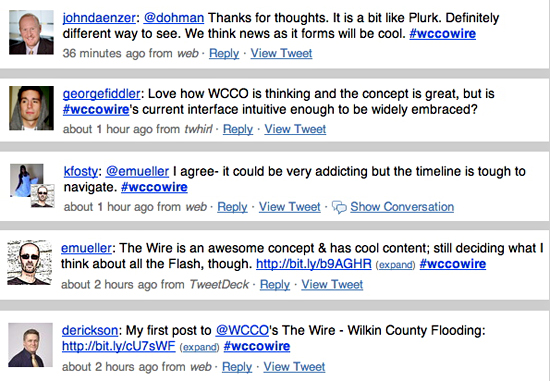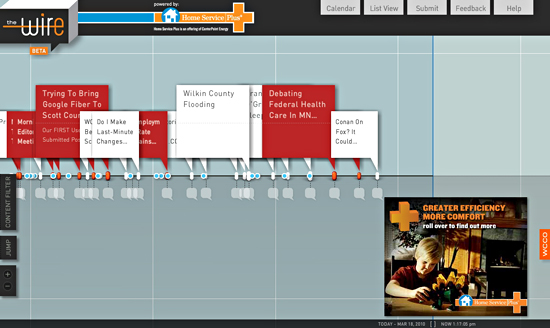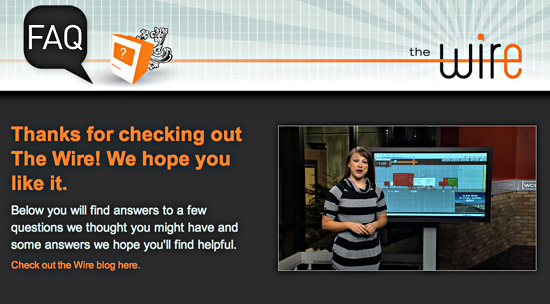People in Twin Cities social media circles got a sneak peek at WCCO’s The Wire last October and its promise looked intriguing. We here at Minnov8 were particularly pleased to see John Daenzer and crew be so bold and embracing risk as it pertains to delivering news in an increasingly changing (and fragmented) media landscape. From what we can see, it looks like the experiment is off to a very strong start.
Here’s how it works: A WCCO reporter or staffer kicks off a story in the timeline. As the story unfolds, updates are done but where it gets interesting is this: We, formerly known as the audience but geared to be highly participative in today’s online world, are able to submit relevant perspective, information, and media we capture digitally and report on the story! In essence, you can connect the dots in your own way and quickly gain additional information and other people’s perspectives on a news story (and how I wished this had been available during the Minneapolis bridge collapse since so many people had multiple angles and photos of what was occurring).
After my adventure attending the WCCO hosted Bloginar in October, Minnov8’s Phil Wilson reported on The Wire with this post, “WCCO Walks The Wire.” In it he interviewed Daenzer about the effort and there is a short screencast. At the bloginar, and in subsequent discussions, Daenzer has been quite clear that they see themselves as engaging the community for input and not trying to be the “ultimate brokers of all news”. If the way that WCCO leaders, reporters and staff have leapt into the social media space and how they’re using it daily is any indication of their sincerity with engagement of the community, The Wire is going to be a resounding success.
The Wire is a platform that recognizes we all have multiple sources for news and information. It also is one that is setup to recognize that fewer of us are willing to be a passive recipient of the news, especially when we have pertinent and relevant pieces of information that really should be part of the discourse if one is to get a holistic view of a story.
With more of us online finding tidbits of information, on the scene with cameras shooting video or photos of an incident or event, The Wire embraces those of us willing to submit our contributions and someone inside WCCO adds us to the timeline if we have relevant information or facts to add to it. With The Wire we are no longer the people known as the audience, we are potentially participants in the story.
The Wire comments on Twitter (hashtag: #wccowire) have been varied thus far, from David Erickson participating with a story, to questions about the interface, to the expected and typical engagement by John Daenzer himself. The Wire has only been out for a few hours and is in “beta” status so the only way to get the ultimate “read” on its usefulness is to have people use it. As more people do use it, I’m certain we’ll see comments that are more praising, and more filled with vitriol, than these few I plucked from a Twitter search:
 No question we social media early adopters will kick the tires on The Wire and give it a good shot and, if what you’re seeing above and in the Twitter search for the #wccowire hashtag, Daenzer and crew will have no shortage of ideas, suggestions, criticisms and rants to take advantage of in its beta phase and continue to quickly evolve this platform. Whether The Wire can migrate to the mainstream is another story and we’ll keep an eye on its adoption curve.
No question we social media early adopters will kick the tires on The Wire and give it a good shot and, if what you’re seeing above and in the Twitter search for the #wccowire hashtag, Daenzer and crew will have no shortage of ideas, suggestions, criticisms and rants to take advantage of in its beta phase and continue to quickly evolve this platform. Whether The Wire can migrate to the mainstream is another story and we’ll keep an eye on its adoption curve.
By the way, as one of the first news stations in Minnesota with a website (www.Channel4000.com done by Internet Broadcasting Systems), WCCO is no stranger to innovation or taking risks. With that willingness, WCCO’s commitment to the community (and engagement with the community), smart people like John Daenzer and crew driving these sorts of initiatives, I have no doubt we’ll see a Minnesota-led platform for the next generation of news and The Wire is a magnificent beginning.

